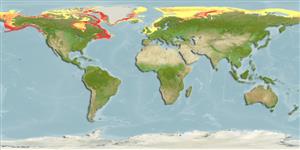Environment: milieu / climate zone / depth range / distribution range
Écologie
marin démersal; profondeur 0 - 647 m (Ref. 50610), usually 100 - 200 m (Ref. 5951). Polar; 84°N - 43°N, 180°W - 180°E (Ref. 117245)
Arctic, Northwest to Northeast Atlantic, Northeast Pacific: Greenland, Canada, and southeastern Alaska (Ref. 2850).
Taille / Poids / Âge
Maturity: Lm ? range ? - ? cm
Max length : 52.0 cm TL mâle / non sexé; (Ref. 2850)
Occurs among seaweeds or rocks (Ref. 7251). Often found in empty scallop shells (Ref. 7251). Benthic species. Feeds on crustaceans (Ref. 58426), such as amphipods and crabs (Ref. 5951).
Life cycle and mating behavior
Maturities | Reproduction | Spawnings | Egg(s) | Fecundities | Larves
Robins, C.R., R.M. Bailey, C.E. Bond, J.R. Brooker, E.A. Lachner, R.N. Lea and W.B. Scott, 1991. Common and scientific names of fishes from the United States and Canada. Am. Fish. Soc. Spec. Publ. (20):183 p. (Ref. 3814)
Statut dans la liste rouge de l'IUCN (Ref. 130435)
Menace pour l'homme
Harmless
Utilisations par l'homme
Outils
Articles particuliers
Télécharger en XML
Sources Internet
Estimates based on models
Preferred temperature (Ref.
123201): -1.4 - 5.9, mean -0.3 °C (based on 868 cells).
Phylogenetic diversity index (Ref.
82804): PD
50 = 0.5000 [Uniqueness, from 0.5 = low to 2.0 = high].
Bayesian length-weight: a=0.01148 (0.00483 - 0.02731), b=3.05 (2.84 - 3.26), in cm total length, based on LWR estimates for this (Sub)family-body shape (Ref.
93245).
Niveau trophique (Ref.
69278): 3.7 ±0.3 se; based on diet studies.
Résilience (Ref.
120179): Milieu, temps minimum de doublement de population : 1,4 à 4,4 années (Fec=4,000-12,000).
Fishing Vulnerability (Ref.
59153): Moderate vulnerability (41 of 100).
